Do you love flowers and soba noodles, and really fun Japanese cultural festivals? Then the Red Buckwheat Festival is the place to go! Walk through the stunning flower fields and learn how to make soba noodles yourself.
One of the best things about traveling slow or living in a country–like Japan– for a year or two is that it gives you the opportunity to experience more than just the most popular sights and festivals. As soon as I found out we were moving back to Japan, I knew I wanted to visit the gorgeous red buckwheat fields in the Nagano Prefecture and find out all about soba noodles, which for me as a foodie is pretty important.
I was happily surprised to find that the town of Minowa hosts a Japanese soba festival each year around the time of the red buckwheat bloom. I booked my hotel before I even arrived in country and couldn’t wait to head to the buckwheat festival in September. No one is going to keep me from learning more about Japanese foods and flowers.

Visiting the Akasoba no Sato or Red Soba Festival
A typhoon was coming. Warnings of rain and high winds were being belted out of loudspeakers accompanied by long, wailing sirens all over the country. A serious typhoon was coming. What do you do when you have travel plans, and the weather sounds like it might make you lose your money?
I don’t know about you, but I go anyway. If you are touring around Japan anywhere between late summer and throughout the fall, chances are there will be a typhoon. What can I say? At least we were heading away from the coast and into the mountains where it would be safer (just wet).
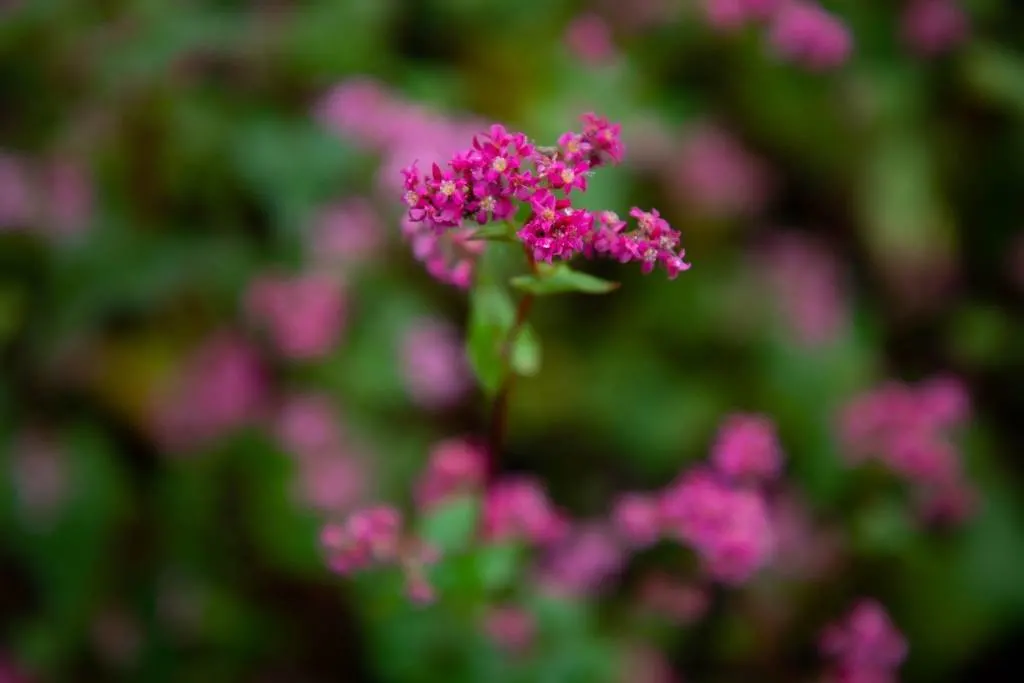
We took off right after work on a Friday afternoon. We were surprised that the traffic wasn’t that bad. Maybe we had the typhoon warnings to thank for that, but either way we were happy to make great time getting to Suwa. Our plan was sketchy at best. We’d seen a couple of photos of buckwheat fields, but fields aren’t buildings and are a little harder to locate. This is the reason we drove instead of taking the train. We figured we would be in for a few turnarounds, a little trial and error. However, in true Japanese fashion, we needn’t have worried. The fields were well marked and it was very easy to get there.
Lunch at the Pokemon Cafe in Tokyo
Best Themed Restaurants in Tokyo
101 Japanese Kit Kat Bars – A Taste Challenge
Mochi, Mochi, Mochi
How to Visit Tsukiji Market
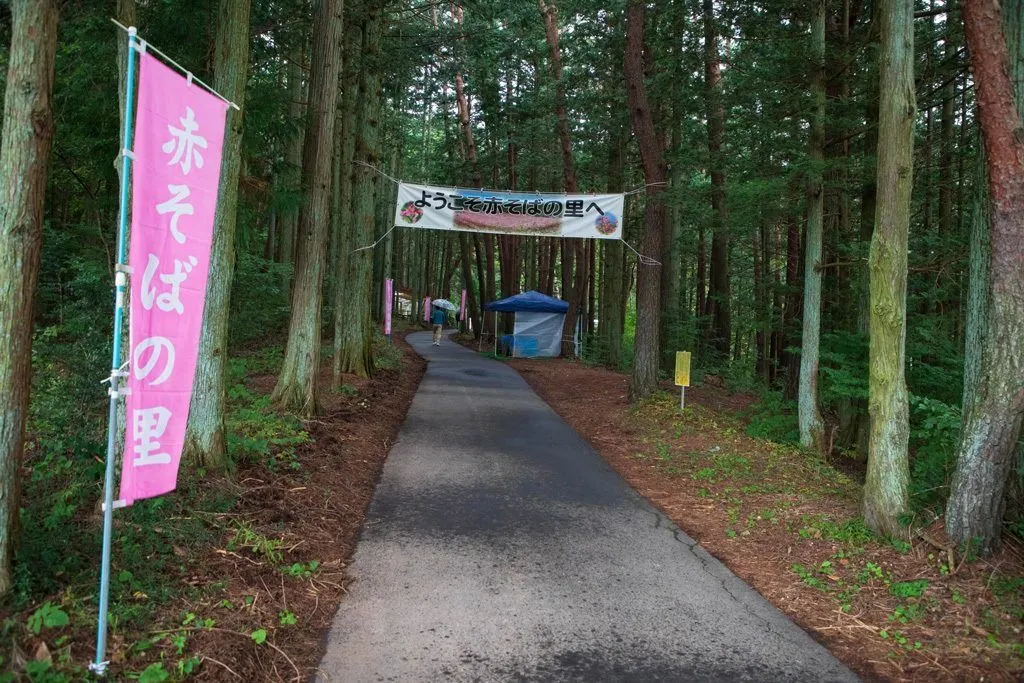
We wanted to get to the fields ahead of the majority of visitors, so that we could make at least a few images without people in them. This was a fruitless endeavor. The longer I live in Japan, I realize that there are plenty of early goers and photographers. We were never going to get there before them all. In fact, we saw a bunch of them leaving as we arrived. They’d taken their photos and were off on their next adventure, before we had finished parking the car.
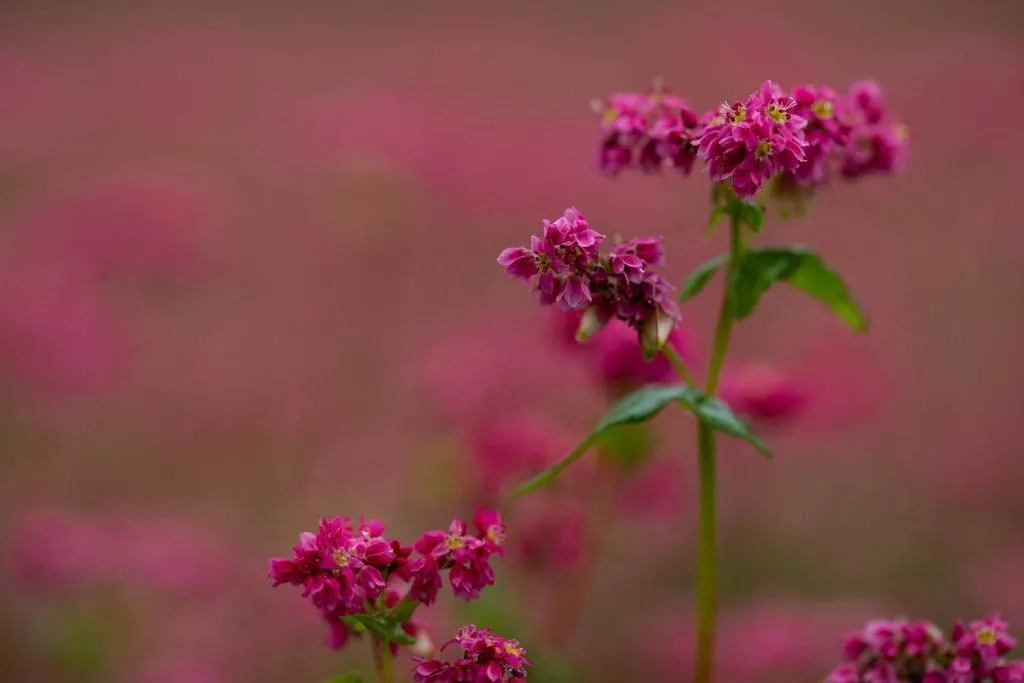
As I mentioned, the fields were well signed, or should I say bannered. The banners started from the main road and made a marked route for us to follow. Even though it was in Japanese, it was easy to recognize the hiragana symbols for “so” and “ba,” and the pink color of the banners assured us that we’d see the red flowers, not the usual white. We parked, donned our rain gear and headed up the paved path. At 8:00 in the morning, there were already a few stands selling vegetables and other local products up and ready to sell. We ambled past them, even though some of their mushrooms looked very enticing.
The path to the red soba flower fields was not very long, but it does take you across a creek and up a short, steep hill. Coming around the bend, though, you are met with the gorgeous maroon fields, with green paths intertwining through them. It looked like a pink, layered wedding cake. Even with the low hanging mist, the rain, and the many umbrellas, the view was breath-taking.
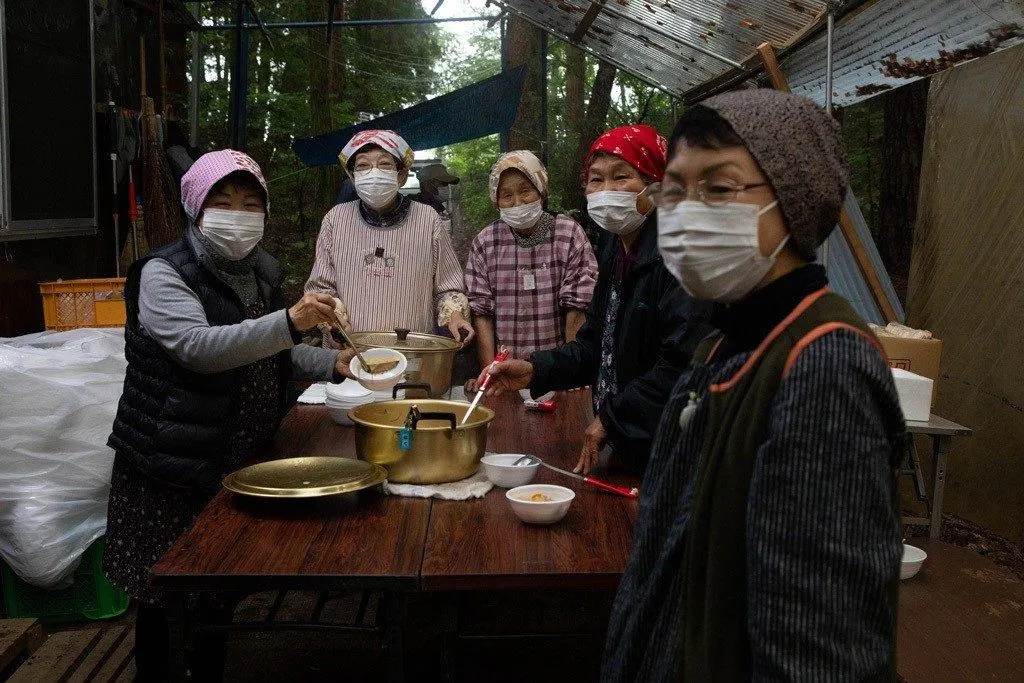
We wandered; we photographed; we did a little bit of people watching while we enjoyed the flowers in the pouring rain. The town had set up a “Dogstagram” spot with labeled frames and folks were taking photos of themselves as well as their dogs. The rain didn’t slow any of them down at all.
If you enjoy unique things you can only do in Japan, check out this podcast!
After our fill of flower viewing, we turned around and walked back to the beginning of the path. There was a tent with many village ladies serving up food. We thought they would be serving soba, but as it turns out they were just giving away free vegetable soup to warm people up. Free. And delicious! What a bonus. We happily, sat and slurped our soup with everyone else, warming up a little before getting back in the car.
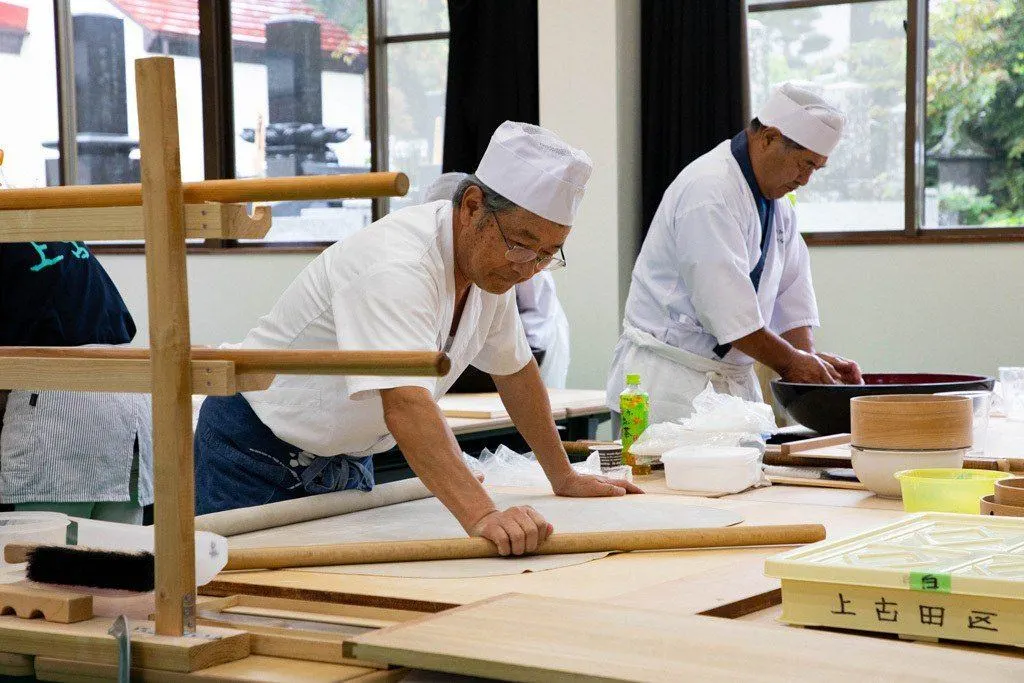
Next we drove to the town hall, not five minutes away. It seems every year, the town of Minowa celebrates their unique and tasty red soba with a small festival. In front of the hall were, of course, a few more vendors selling produce and handicrafts. We couldn’t help but buy a couple bags of potatoes from the school children.
Upon entering, we bought tickets to taste the soba. The regular white or “mori” soba was 500 yen per serving, and the celebrated red soba was 900 yen per serving. Jim and I both opted for the red soba. That’s why we were here after all.
At that point, you go stand by a table and wait for your ticket number to be called. When it is, the waiter will bring the tray of freshly cooked and cooled soba to you. The serving of noodles is accompanied by a dark, flavorful broth. You can further add some sliced spring onions and wasabi to your broth to really pack a punch. We added both.
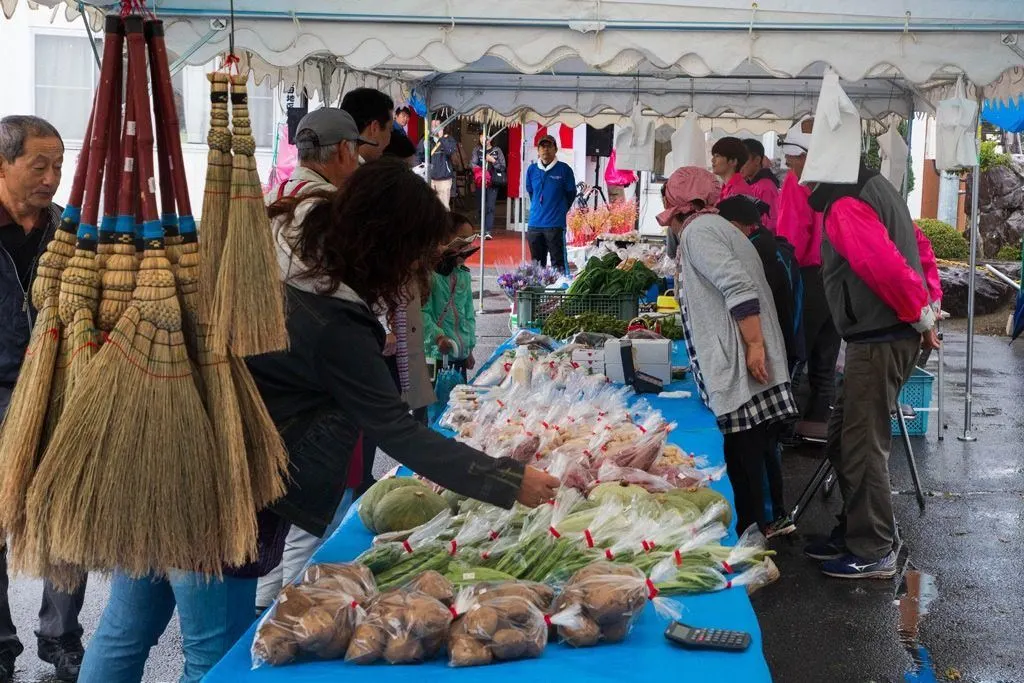
To eat the soba, you pick up the noodles, drop it in the broth and slurp it down from there. The noodles can be served either cold or hot, and it really doesn’t matter, because the broth is warm and the taste just makes your tongue happy!
Stuffed with noodles and broth, we took off looking for more things to do in the Suwa region. However, the rain hadn’t let up so we eventually decided to call it quits and get home before the typhoon hit in full force. It was a good thing we did, too. Typhoon Trami’s winds were the strongest they’d had in 20 years.
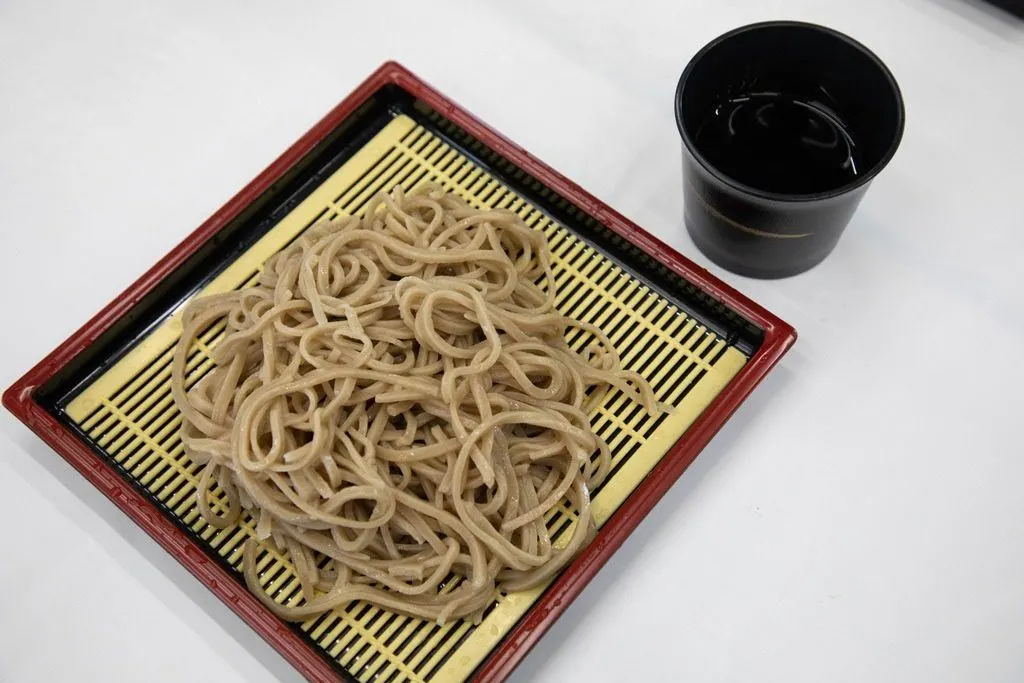
How to Eat Soba Noodles in Japan
The dining tables only took up one half of the room. On the other half, locals were in all stages of making the soba noodles from the finely ground soba flour. We enjoyed watching them and each chef’s unique, meticulous manner of kneading, rolling, cutting, and stacking their noodles. From the noodle makers, the noodles were taken out back where another group of ladies was boiling them up for the customers waiting inside. It was quite the production.
Best Time to Visit Red Buckwheat Fields
The stunning pink flowers are in full bloom starting in mid-September, and they last until early October. The weather can be rainy, as it was when we were there, so it’s smart to bring an umbrella and a light rain jacket or windbreaker.
You will also need to bring a tripod for the up close shots of the blooms.
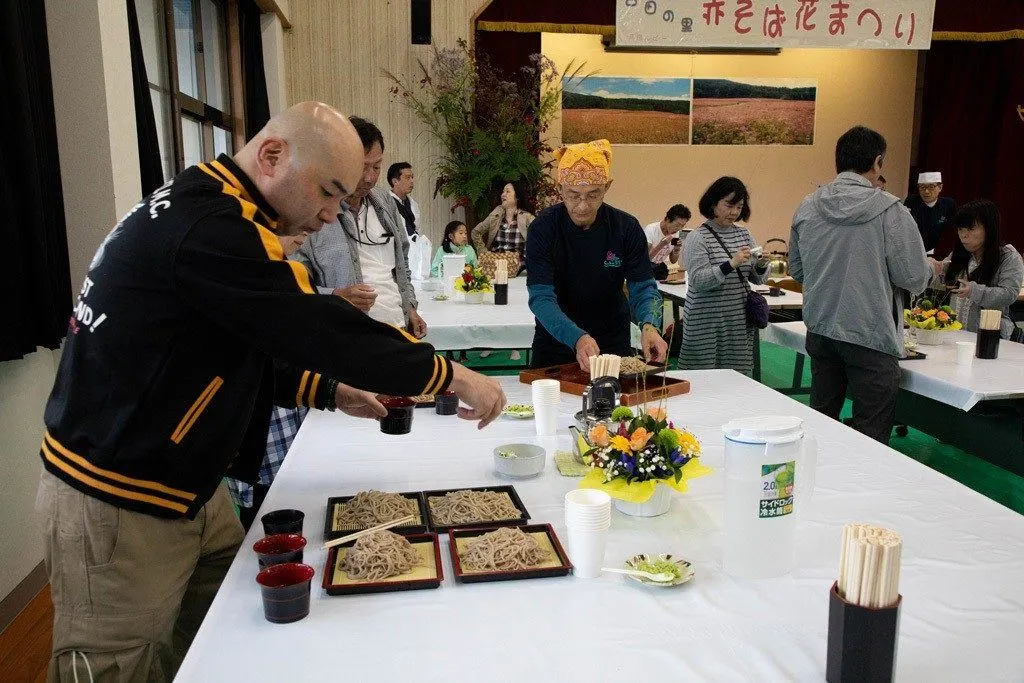
Details about the Red Soba Festival
- Official Title is: Furuta no Sato
- When: It is usually held the last weekend in September, but check the website to make sure it’s not been changed.
- Free entry and free parking at both places, the town hall where the soba making and eating takes place and the red buckwheat fields.
- If you are interested in eating the soba, there is an additional cost (less than $10).
How to Get from Tokyo to Minowa
We drove to Minowa, which really gave us the flexibility to get to the fields early so that we could avoid many of the crowds, but in Japan practically everything is also accessible by train, bus, and taxi. You must be careful when taking the train, because there is a Minowa station only 20 minutes from Tokyo, and that is not the right place. The Minowa with the red soba fields is located in the Nagano Prefecture. The train should take around three hours. It would be best to go to the JR ticket office to ensure you are buying the correct ticket and getting an itinerary where you might have to change trains. Take the JR Iida Line and get off at the Ina-Matushima station. From there you must hire a taxi to get to the very small city of Minowa, and it will take you 20 minutes. There really is no bus that will take you right to the small town of Minowa.
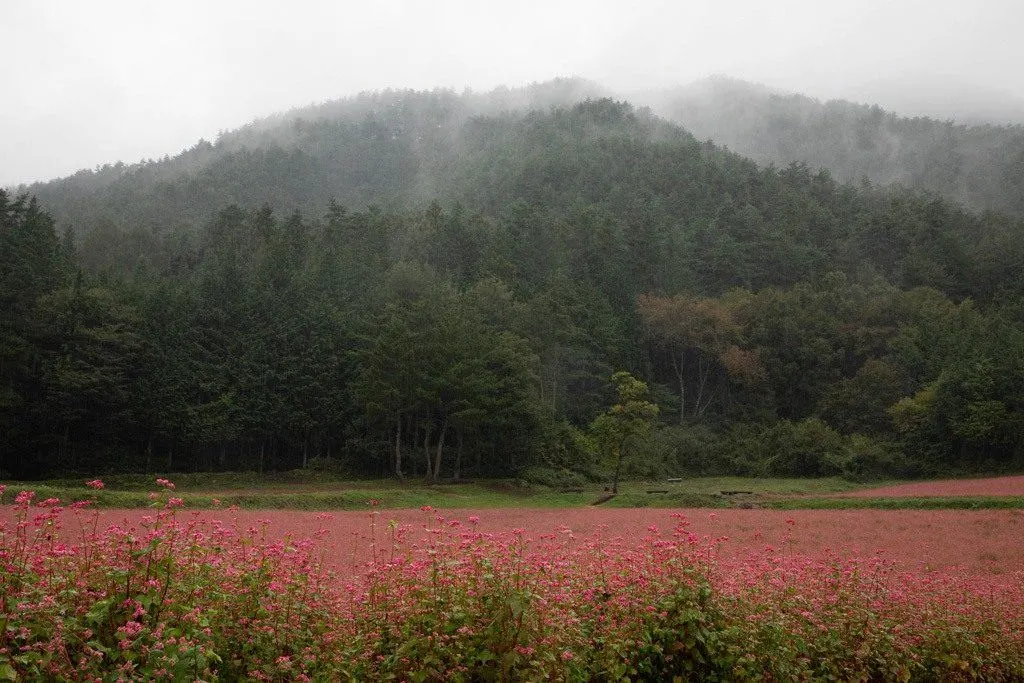
Can you do the Red Soba Fields in one day?
We only spent about three hours total walking around the fields, taking photos, then watching them make the soba noodles and of course eating some as well. Three hours may be more than most people would need, though. So, yes, you can do the fields in less than a day, but I would not try to do it as a day trip from Tokyo unless I was really limited for time. Instead I would combine it with a few other beautiful spots in the Nagano region, like Matsumoto, Nagano City, or even the Snow Monkeys which are all within a couple of hours drive.
Nearby Places to Visit
- Matsumoto and Its Castle – 1 hour
- Snow Monkeys in Jikokudani Park – 1.5 hours
- Nagano – 1 hour
Are you interested in making your own red buckwheat images during the Minowa Red Soba Festival?
Author Bio: Corinne Vail is a travel photographer, food lover, and a perpetual traveler who has been travel writing for over 14 years. For many years she lived overseas in Germany, Japan, Turkey, South Korea, and the Netherlands teaching the children of the US. military. She’s visited over 90 countries, and she’s not stopping anytime soon.
Pin the Red Soba Festival of Minowa for your future planning purposes.
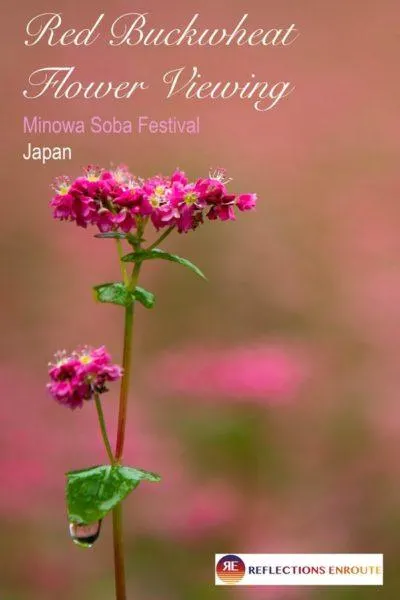
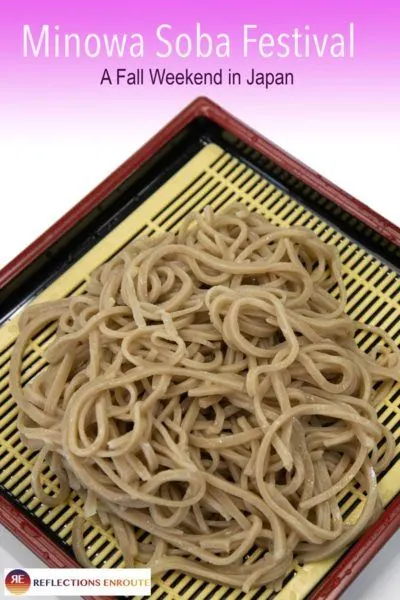

Zaw Myo Aung
Tuesday 13th of September 2022
Thank you so much for your every information for Soba Festival in Nagano, Minowa machi . It is really nice and very beautiful red flowering of soba farm . I am from Myanmar and i am also cultivation of Buckwheat farm for every year in Shan state areas and also i have experience with Red soba farm for the test cultivation in Northern shan state area.
Jim Vail
Sunday 18th of September 2022
I would love to go there and see your farm. Buckwheat is so beautiful!
Holly
Sunday 17th of February 2019
I love cooking with Soba noodles! How interesting to see where they come from!
Corinne Vail
Sunday 17th of February 2019
Holly, It's fascinating isn't it to see where it comes from?
Clazz - An Orcadian Abroad
Saturday 16th of February 2019
This looks like a great festival! You certainly made the most of the bad weather. Sometimes I think you just have to go with it and see what happens. :)
Corinne Vail
Saturday 16th of February 2019
When it's only a weekend, or you are only there a short time weather just has to take a back seat!
Emma Jane Explores
Friday 15th of February 2019
Looks beautiful! I've never heard of this spot, but will definitely be adding it to my Japan bucket list for my next trip. What an incredible way to see this part of Japanese culture.
Corinne Vail
Saturday 16th of February 2019
Emma Jane, It was a great weekend, and we loved being the only foreigners at this small, local festival!